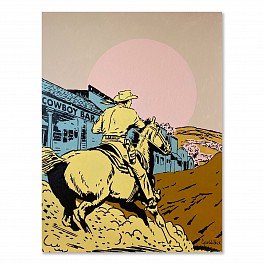BIOGRAPHY

Cyrus Walker’s art is inspired by the power of the press and the production of commercial quality art. Cyrus’ work reflects and manipulates the mass-produced dime novels and comic books that influenced the themes of the west.
The Western art genre is a carful balance of mythology and preservation. At some point in the history of the Western art genre there was a removal of the artist capturing the scenes and events surrounding them, replaced with the more fictional tales of the west. With help from the enthusiastic collectors and art connoisseurs residing in the eastern United States, the western genre began to take form. It is an interesting form of art because there is just as much fiction as there is fact. The western genre began to embody the ideas that we recognize today; men are rough, rugged and chivalrous. Vicious outlaws mingle with proud pioneers at a rowdy poker table, and disputes are settled with a gunfight. These events are surrounded by majestic mountain peaks and drifting tumbleweeds.
The early western painters paved the way for the phenomenon known as the “Imagined West”. Their artwork made appearances in national magazines and other popular publications. The eager masses gobbled up the imagery and helped build the “Idea of the West”. These ideas of the mystical and Wild West became solidified as the mass production of dime novels that emerged in 1859 by Beadle’s Novel Publishing House. These novels suggested the depth to which the Wild West had penetrated popular society. There was enough documentation and collective opinion to generate tall tales from factual stories about the events of the land beyond the Mississippi. The mass persuasion and shared recollections of the west, both factual and fictional, peaked Cyrus’ curiosity.
Cyrus studied graphic design and was fascinated by the power that mass- produced print products can have on forming the identity of the west. While studying art, Cyrus also worked at an antique store that exposed him to vintage documents and publications, setting him on a path to study the widely distributed work. Cyrus’ work is not created in a classical western style. Instead, he uses classic ideas and commercial style to capture and manipulate the “Imagined West”.
